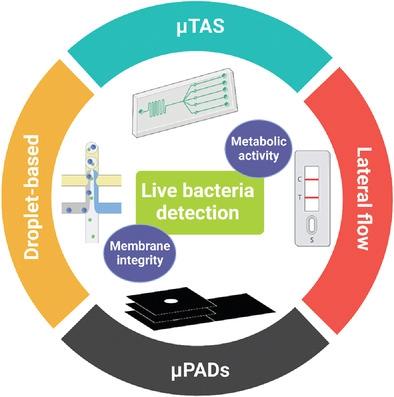当前位置:
X-MOL 学术
›
Adv. Funct. Mater.
›
论文详情
Our official English website, www.x-mol.net, welcomes your
feedback! (Note: you will need to create a separate account there.)
Microfluidics for Rapid Detection of Live Pathogens
Advanced Functional Materials ( IF 18.5 ) Pub Date : 2023-03-03 , DOI: 10.1002/adfm.202212081 Carla Spatola Rossi 1 , Frederic Coulon 1 , Shaohua Ma 2 , Yu Shrike Zhang 3 , Zhugen Yang 1
Advanced Functional Materials ( IF 18.5 ) Pub Date : 2023-03-03 , DOI: 10.1002/adfm.202212081 Carla Spatola Rossi 1 , Frederic Coulon 1 , Shaohua Ma 2 , Yu Shrike Zhang 3 , Zhugen Yang 1
Affiliation

|
Rapid, sensitive, and selective detection of live pathogens remains a key priority for quality control and risk assessment. While conventional methods often require complicated workflows, costly reagents, lab equipment, and are time-consuming, rendering them inadequate for field testing and low-resource settings. Increased attention has been drawn to developing alternative low-cost and rapid methods to detect on-site live pathogens in different environmental matrices. Among them, microfluidic devices that integrate various laboratory functions in a miniaturized manner have proven to be a promising tool for the rapid and sensitive detection of pathogens. Herein, the development of microfluidic devices specifically designed for the detection of live pathogens is discussed along a concise summary of novel microfluidics systems recently developed, contrasted to conventional methods regarding assay time, the limit of detection, and target organisms. These include a variety of micro total analysis systems (µTAS) and microfluidic paper-based analytical devices (µPADs) in combination with molecular methods and traditional live cell detection techniques, such as cell culture, DNA intercalating dyes, resazurin, and immobilized bioreceptors (e.g., aptamers and capture antibodies). Furthermore, insights on the future perspectives of microfluidics for live pathogen detection with a highlight on the rapid and low-cost method development for field testing are provided.
中文翻译:

用于快速检测活病原体的微流体
快速、灵敏和选择性地检测活病原体仍然是质量控制和风险评估的关键优先事项。虽然传统方法通常需要复杂的工作流程、昂贵的试剂、实验室设备,并且耗时,但不适合现场测试和资源匮乏的环境。人们越来越关注开发替代的低成本和快速方法来检测不同环境基质中的现场活病原体。其中,以小型化方式集成各种实验室功能的微流控装置已被证明是一种有前途的快速灵敏检测病原体的工具。在此,我们讨论了专门为检测活病原体而设计的微流体设备的开发,以及对最近开发的新型微流体系统的简要总结,与有关测定时间、检测限和目标生物的常规方法形成对比。这些包括各种微型全分析系统 (µTAS) 和微流体纸基分析设备 (µPAD),结合分子方法和传统活细胞检测技术,例如细胞培养、DNA 嵌入染料、刃天青和固定化生物受体(例如、适体和捕获抗体)。此外,还提供了对用于活体病原体检测的微流体的未来前景的见解,重点介绍了用于现场测试的快速和低成本方法开发。这些包括各种微型全分析系统 (µTAS) 和微流体纸基分析设备 (µPAD),结合分子方法和传统活细胞检测技术,例如细胞培养、DNA 嵌入染料、刃天青和固定化生物受体(例如、适体和捕获抗体)。此外,还提供了对用于活体病原体检测的微流体的未来前景的见解,重点介绍了用于现场测试的快速和低成本方法开发。这些包括各种微型全分析系统 (µTAS) 和微流体纸基分析设备 (µPAD),结合分子方法和传统活细胞检测技术,例如细胞培养、DNA 嵌入染料、刃天青和固定化生物受体(例如、适体和捕获抗体)。此外,还提供了对用于活体病原体检测的微流体的未来前景的见解,重点介绍了用于现场测试的快速和低成本方法开发。
更新日期:2023-03-03
中文翻译:

用于快速检测活病原体的微流体
快速、灵敏和选择性地检测活病原体仍然是质量控制和风险评估的关键优先事项。虽然传统方法通常需要复杂的工作流程、昂贵的试剂、实验室设备,并且耗时,但不适合现场测试和资源匮乏的环境。人们越来越关注开发替代的低成本和快速方法来检测不同环境基质中的现场活病原体。其中,以小型化方式集成各种实验室功能的微流控装置已被证明是一种有前途的快速灵敏检测病原体的工具。在此,我们讨论了专门为检测活病原体而设计的微流体设备的开发,以及对最近开发的新型微流体系统的简要总结,与有关测定时间、检测限和目标生物的常规方法形成对比。这些包括各种微型全分析系统 (µTAS) 和微流体纸基分析设备 (µPAD),结合分子方法和传统活细胞检测技术,例如细胞培养、DNA 嵌入染料、刃天青和固定化生物受体(例如、适体和捕获抗体)。此外,还提供了对用于活体病原体检测的微流体的未来前景的见解,重点介绍了用于现场测试的快速和低成本方法开发。这些包括各种微型全分析系统 (µTAS) 和微流体纸基分析设备 (µPAD),结合分子方法和传统活细胞检测技术,例如细胞培养、DNA 嵌入染料、刃天青和固定化生物受体(例如、适体和捕获抗体)。此外,还提供了对用于活体病原体检测的微流体的未来前景的见解,重点介绍了用于现场测试的快速和低成本方法开发。这些包括各种微型全分析系统 (µTAS) 和微流体纸基分析设备 (µPAD),结合分子方法和传统活细胞检测技术,例如细胞培养、DNA 嵌入染料、刃天青和固定化生物受体(例如、适体和捕获抗体)。此外,还提供了对用于活体病原体检测的微流体的未来前景的见解,重点介绍了用于现场测试的快速和低成本方法开发。


















































 京公网安备 11010802027423号
京公网安备 11010802027423号